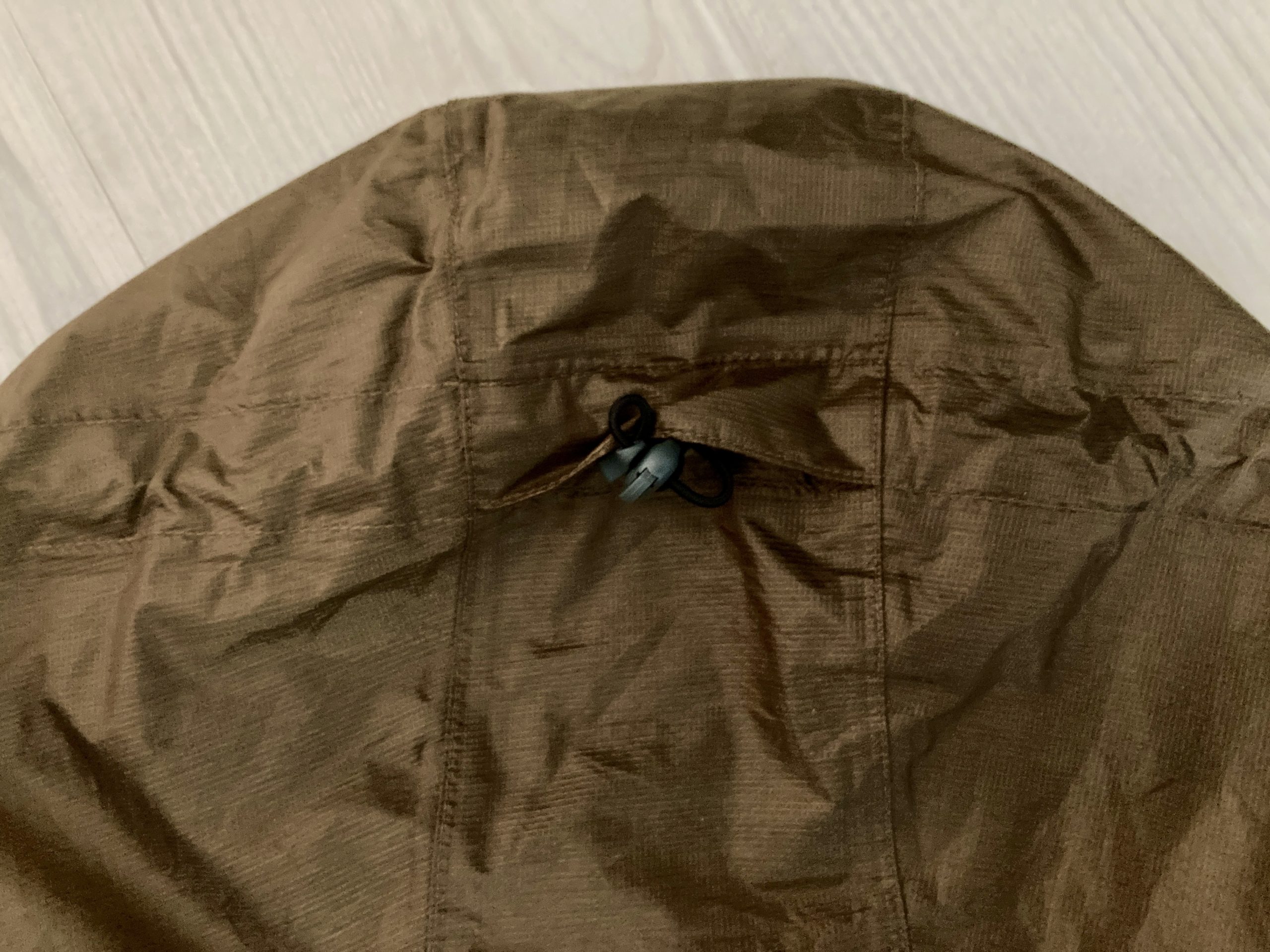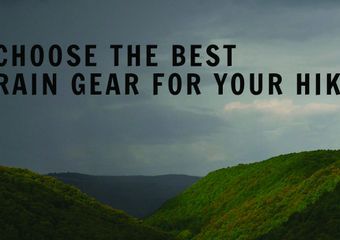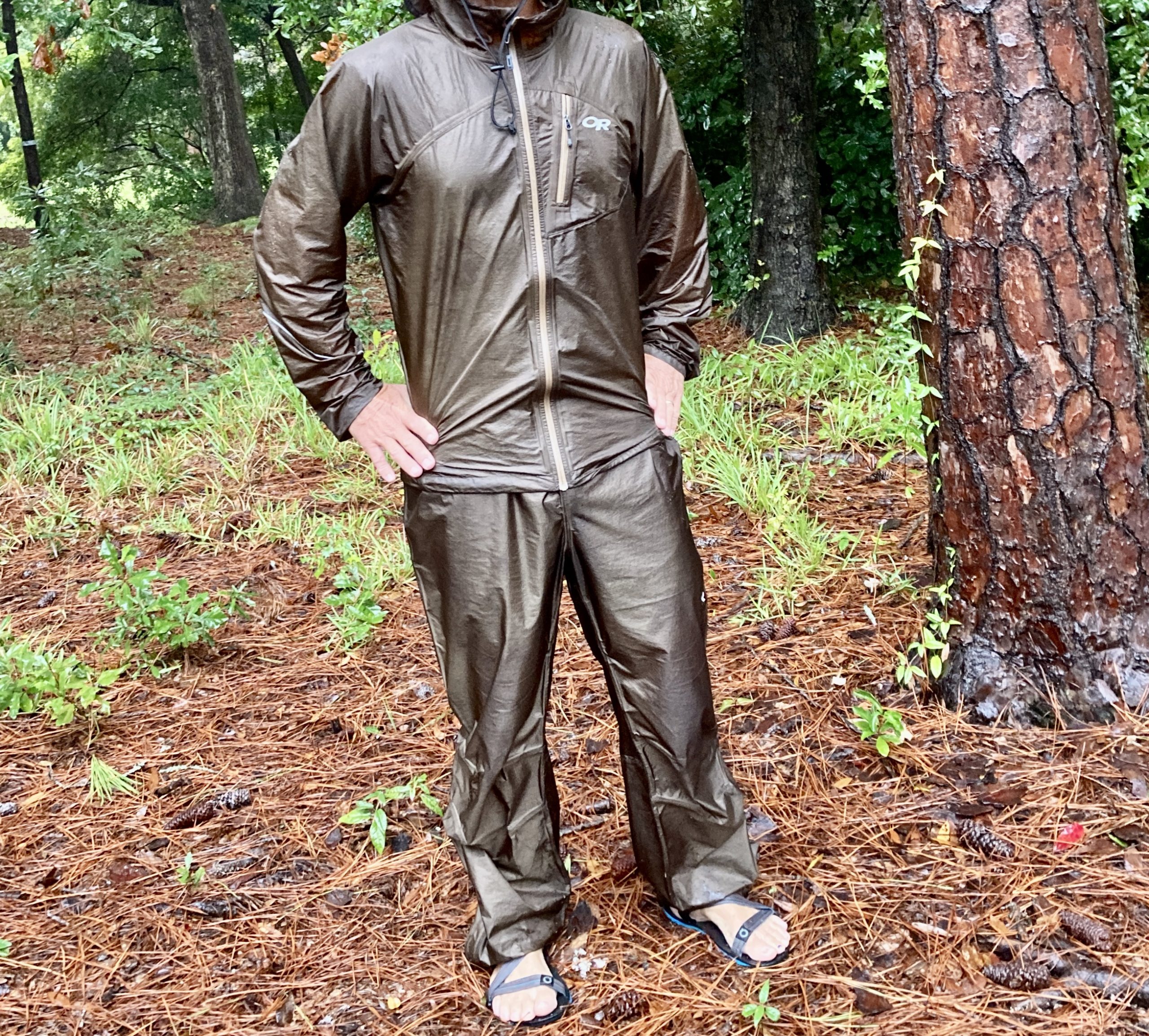Outdoor Research Helium Rain Jacket and Pants Review
During my first long-distance hike (not counting Boy Scout 50-milers and a trek around the Annapurna massif in Nepal many moons ago), I was furious when my rain jacket failed to protect my phone during a torrential downpour in the La Garita Wilderness in southern Colorado. I walked the last 150 miles of the Colorado Trail sans iPhone, grumpily blaming Mountain Hardwear for producing a defective product.
It wasn’t until about nine months later, as I walked on the Appalachian Trail in a new rain jacket, that I had an epiphany. Whether you spend $650 on an Arc’teryx jacket or $25 on Frogg Toggs, if you are thru-hiking, you are going to get wet. Sweat inside and enough precipitation outside all but guarantees it.
With that in mind, I’ve bought all subsequent rain gear with realistic expectations and an eye toward weight. Even if you do soak through, a good, lightweight jacket cuts the wind and is a critical part of your gear.
I’ve always waved off rain pants, believing that they would simply become more sodden material clinging to my skin as I hiked through the rain. But having used and greatly appreciated Outdoor Research’s popular Helium rain jacket, I was intrigued when I got the opportunity to try out the latest version of both the Helium jacket and pants.
This is lightweight rain gear, which means low-frills rain gear. But it’s definitely not no-frills rain gear.
Outdoor Research Helium Rain Jacket and Pants At-A-Glance
MSRP: $159 (jacket); $119 (pants)
Weight: 13 ounces (pants – 6.7; jacket – 6.3)
Material: 2.5-layer, 30D ripstop
Waterproofing: Pertex Shield Diamond Fuse
Testing Conditions
I wore the jacket numerous times in South Carolina in varying conditions, from light rain to torrential downpours generated by hurricanes and tropical storms offshore, for as long as two hours. Temperatures ranged from the mid-60s to upper-70s.
Quick Aside on Hiking in the Rain
I had a running conversation with Patches, a member of my AT trail family in Virginia, about when to don rain gear. Over time, and through one very nasty, dangerous sleet-rain-windstorm, we decided that if the air is 50 degrees or below, and rain is more than a pitter-patter, we’d use a jacket. From 50 to 65 degrees, it’s a tossup, depending largely on whether you are going uphill. Above 65, I don’t bother putting rain gear on at all (unless there is considerable wind, which can accelerate hypothermia). In all honesty, the most breathable rain jacket I’ve ever worn is a Frogg Toggs Ultra-Lite 2.

The Outdoor Research Helium Rain Jacket and Pants after a two-hour downpour. Clay Bonnyman Evans photo.
Features
- Outdoor Research’s proprietary Pertex Shield Diamond Fuse waterproof material, touted as having “five times the tear strength of the (previous) Helium fabric, with a 50 percent higher waterproof rating.”
- YKK® AquaGuard® zippers
- Seam-taped
- Lighter than previous iterations of Helium rain gear
- Unique back-of-the-head system for adjusting the hood; elastic cuffs and hem drawcord
- Jacket chest pocket doubles as compact stuff sack
- Pants pocket doubles as compact stuff sack
- Adjustable waistband
- Leg zippers makes donning and removing easier, and can serve as ventilation
Waterproofing: Having gone into the heaviest rain expecting to be completely soaked within 10 or 15 minutes, I was pleasantly surprised by the performance of both jacket and pants. The jacket fended off rain for a good half an hour on the front, back, and shoulders, and a bit less in the arms; water continued to bead on the fabric for almost that entire time. As always, I experienced soaking more quickly and intensively in the forearm and wrist areas – this may be due to the fact that these areas move constantly from vertical to more horizontal angles. But I was surprised and impressed by the pants. I walked six miles in a near-constant, pouring rain and the shorts beneath the pants were just barely damp; the pants cuffs were wetter, but lower legs also remained dry. I’m no longer the rain pants doubter I was before!
Breathability: As far as it goes, the Helium ensemble is pretty breathable, no worse than other rain gear I’ve tried. On the AT I found that the minute I headed up the next steep hill I needed to fully unzip my earlier-model Helium jacket or shuck it entirely, or I’d soon be soaked from the inside out.
Weight: This is, frankly, the major selling point of Helium rain gear. Though, as I mentioned, I don’t think even the fanciest, most-expensive gear will actually prevent you from getting wet in persistent rain, a little less rain protection is a price you pay for shaving weight. And 13 ounces is not bad for a jacket-pants combo.
Storage: It’s great to be able to quickly stuff both pieces into attached pockets for easy packing and location.

Helium jacket (right) and pants (left) in pocket-stuff sacks. Ruler and old-school size 8.5 Altra Lone Peak for scale. Clay Bonnyman Evans photo.
Comfort: Most rain gear gets clingy once it gets wet, but the fabric-like texture inside the Helium minimizes that irritation. Wet jacket cuffs never feel great, but that’s no worse than on any other rain gear I’ve tried.
Hood: I don’t find that the stiff hood panel in front does much of anything in the rain. However, tightening up the adjustable cord on the back makes it less floppy and more useful as a rain guard.

The rear-drawcord system makes the Helium jacket’s hood easy to adjust according to conditions. Clay Bonnyman Evans photo.
Durability: Honestly, I’ve used my 2016-era Helium jacket for some 3,000 miles of backpacking, and it’s still in great shape. Given that the latest model features even tougher, yet lighter, material, I can only assume it’s going to hold up pretty darn well.
Sizing: When asked for my size, I went with a small jacket and medium pants, which seemed right. That said, I think the jacket does run a little small, and if you’re looking for a bit more room, bump up a size.
Price: While definitely not inexpensive, the Helium jacket and pants are still considerably less than you could spend on lightweight rain gear.
Pros
- Genuinely lightweight
- Good protection for such lightweight material
- Convenient pocket/stuff sack storage
- Lots of great colors (so why I do keep choosing “Coyote,” which is basically a shiny brown?)
Cons
- Minimal pockets
- Price of combo may be steep for some hikers
- Not super breathable
- You will get wet; but then, that’s true of all rain gear when backpacking

Wearing the Outdoor Research Helium jacket for wind protection on Mount Garfield, New Hampshire. Clay Bonnyman Evans photo.
Overall
I’m definitely going to stick with the Helium jacket. My older model has worked well (so long as I don’t have unrealistic expectations) and the new iteration seems even better. As great as these rain pants performed, I still don’t see myself regularly packing them on a long-distance trip, unless I’m expecting winter conditions. It’s just 6.7 ounces, but you know what they say about ounces adding up to pounds, and I’m used to wet legs by now.
P.S. Sorry, Mountain Hardwear, for grousing about your rain gear when I was a newb – I didn’t know any better!
Shop the OR Helium Rain Jacket
Comparable Rain Gear
Montbell Versalite Jacket and Pants
- Jacket: $199; 6.4 ounces; two hand pockets; pit-zips; adjustable hood, hem
- Pants: $139; 3.2 ounces; no pocket; ankle zippers
Enlightened Equipment Custom Visp Rain Jacket and Pants
- Jacket: $199; 4.2 ounces; no pockets
- Pants: $160; 4.04 ounces; no pockets; ankle zippers
Frogg Toggs Ultra-Lite 2 Rain Suit
- $29.99 for suit; 12.8 ounces; no pockets; no ankle zippers
This website contains affiliate links, which means The Trek may receive a percentage of any product or service you purchase using the links in the articles or advertisements. The buyer pays the same price as they would otherwise, and your purchase helps to support The Trek's ongoing goal to serve you quality backpacking advice and information. Thanks for your support!
To learn more, please visit the About This Site page.

 ">
">





Comments 2
Ponchos weren’t mentioned and I’m planning on using the Sea to Summit nano at BSA’s Philmont trek. It is listed at 8.1 oz yet mine scaled a 7. It’s a rain cover that goes to my mid arm and hits above my knees. It also covers my pack since the back is longer and is an emergency shelter or dining fly wrapped up to the size of a soda can and was a good price point on Amazon. The sides snap so you don’t flap as much. The nice thing is that ponchos are breathable – my Patagonia torrentshell was heavy but thank goodness for pit zips. I think if the weather won’t go below freezing then something like this can be another option to consider. Would love some feedback.